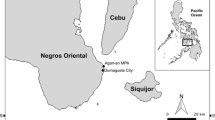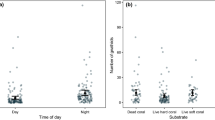Abstract
Gnathiid isopods are one of the most abundant groups of ectoparasites on coral reef fishes. They, and other isopods, have been shown to significantly affect the health and behaviour of many reef fish. Whether isopod emergence differs among habitats on coral reefs is not known. In this study, we measured emergence rates of parasitic isopods (Gnathiidea and Flabellifera) in six habitats at two sites at Lizard Island during new moon periods in March and December 2004. Isopods were collected from the periphery and centres of micro-reefs, patch reefs, continuous reefs, and from inter-reefal habitats (sand or rubble) with 1 m2 emergence traps. Sites (Casuarina and Coconut Beach) were located on opposite sides of Lizard Island. Live gnathiids were collected with light traps in November 2005 to investigate species differences between sites. At both sites, the most abundant gnathiid species was exclusive to that site. More gnathiid larvae emerged at night, and emergence of fed gnathiids (pranizae) and flabelliferan isopods was almost exclusively nocturnal. Diurnal emergence was greater at Coconut Beach than Casuarina Beach. Although emergence counts were not consistently affected by parameters such as habitat, site, or sampling period, gnathiid size and feeding state were. Where significant differences existed, gnathiids were larger and more often fed over reef borders than centrally. We suggest first stage larvae (Z1) have the largest influence on total abundance and are patchily distributed in accordance with adults from which they have recently hatched. As later stage larvae depend on fish, more successful (fed) and older larvae are found on the edges of reefs where appropriate hosts may be more abundant, or predation is lower. Gnathiids were over-dispersed in all habitats investigated, including apparently homogeneous beds of coral rubble and sand. This indicates that their distributions may be better predicted by very fine scale differences in substrate or that aggregations are the result of gregariousness and may be difficult to predict on the basis of substrate. Emergence traps collected comparatively few parasitic flabelliferan isopods. This community differed greatly from the previously described community of scavenging isopods at Lizard Island. These differences are probably the result of differences in trapping methodology.





Similar content being viewed by others
References
Adlard RD, Lester RJG (1994) Dynamics of the interaction between the parasitic isopod, Anilocra pomacentri, and the coral reef fish, Chromis nitida. Parasitology 109:311–324
Bruce NL (1986) Cirolanidae (Crustacea: Isopoda) of Australia. Rec Aust Mus 6:1–239
Brusca RC (1981) A monograph on the Isopoda Cymothoidae (Crustacea) of the eastern Pacific. Zool J Linn Soc 73:117–119
Chambers SD, Sikkel PC (2002) Diel emergence patterns of ecologically important, fish-parasitic, gnathiid isopod larvae on Caribbean coral reefs. Caribb J Sci 38:37–43
Clarke RD (1988) Chance and order in determining fish species composition on small coral patches. J Exp Mar Biol Ecol 115:197–212
Cohen GF, Poore GCB (1994) Phylogeny and biogeography of the Gnathiidae (Crustacea: Isopoda) with descriptions of new genera and species, most from south-eastern Australia. Mem Mus Vic 54:271–397
Crawley MJ (2005) Statistics: an introduction using R. Wiley, Chichester
Cribb TH, Anderson GR, Dove ADM (2000) Pomphorhynchus heronensis and restricted movement of Lutjanus carponotatus on the Great Barrier Reef. J Helminthol 74:53–56
Dobson AJ (1991) An introduction to generalized linear models. Chapman & Hall, London
Dunn OJ (1964) Multiple contrast using rank sums. Technometrics 6:241–252
Grutter AS (1994) Spatial and temporal variations of the ectoparasites of seven reef fish species from Lizard Island and Heron Island, Australia. Mar Ecol Prog Ser 115:21–30
Grutter AS (1996) Parasite removal rates by the cleaner wrasse Labroides dimidiatus. Mar Ecol Prog Ser 130:61–70
Grutter AS (1998) Habitat-related differences in the abundance of parasites from coral reef fish: an indication of the movement patterns of Hemigymnus melapterus. J Fish Biol 53:49–57
Grutter AS (1999) Infestation dynamics of parasitic gnathiid isopod juveniles on a coral reef fish Hemigymnus melapterus. Mar Biol 135:545–552
Grutter AS (2001) Parasite infection rather than tactile stimulation is the proximate cause of cleaning behaviour in reef fish. Proc R Soc Lond B 268:1361–1365
Grutter AS (2003) Feeding ecology of the fish ectoparasite, Gnathia sp. (Crustacea: Isopoda), from the Great Barrier Reef, Australia and its implications for fish cleaning behaviour. Mar Ecol Prog Ser 259:295–302
Grutter AS, Lester RJG (2002) Cleaner fish Labroides dimidiatus reduce ‘temporary’ corallanid isopods on the coral reef fish Hemigymnus melapterus. Mar Ecol Prog Ser 234:247–255
Grutter AS, Poulin R (1998) Intraspecific and interspecific relationships between host size and the abundance of parasitic larval gnathiid isopods on coral reef fishes. Mar Ecol Prog Ser 164:263–271
Grutter AS, Lester RJG, Greenwood J (2000a) Emergence rates from the benthos of the parasitic juveniles of gnathiid isopods. Mar Ecol Prog Ser 207:123–127
Grutter AS, Morgan JAT, Adlard RD (2000b) Characterising parasitic gnathiid isopod species and matching life stages using ribosomal DNA ITS2 sequences. Mar Biol 136:201–205
Grutter AS, Murphy J, Choat H (2003) Cleaner fish drives local fish diversity on coral reefs. Curr Biol 13:64–67
Hobson ES, Chess JR (1976) Trophic interactions among fishes and zooplankters near shore at Santa Catalina Island, California. Fish Bull 74:567–598
Holdich DM, Harrison K (1980) The crustacean isopod genus Gnathia Leach from Queensland waters with descriptions of nine new species. Aust J Mar Freshw Res 31:215–240
Jacoby CA, Greenwood JG (1988) Spatial, temporal, and behavioral patterns in emergence of zooplankton in the lagoon of Heron Reef, Great Barrier Reef, Australia. Mar Biol 97:309–328
Jones CM, Grutter AS (2005) Parasitic isopods (Gnathiia sp.) reduce haematocrit in captive blackeye thicklip (Labridae) on the Great Barrier Reef. J Fish Biol 66:860–864
Keable SJ (1995) Structure of the marine invertebrate scavenging guild of a tropical reef ecosystem: field studies at Lizard Island, Queensland, Australia. J Nat Hist 29:27–45
Klitgaard AB (1991) Gnathia abyssorum (G. O. Sars, 1872) (Crustacea, Isopoda) associated with sponges. Sarsia 76:33–40
Lafferty KD, Kuris AM (2002) Trophic strategies, animal diversity and body size. Trends Ecol Evol 17:507–513
McLain DK, Pratt AE (1999) Nestedness of coral reef fish across a set of fringing reefs. Oikos 85:53–67
Monod T (1926) Les gnathiidae. Essai monographique (morphologie, biologie, systématique). Mém Soc Sci Nat Maroc 13:1–661
Mouchet S (1928) Note sur le cycle évolutif des Gnathiidae. Bull Soc Zool Fr 53:392–400
Mugridge RER, Stallybrass HG (1983) A mortality of eels, Angulla anguilla L., attributed to Gnathiidae. J Fish Dis 6:81–82
Pratchett MS (2005) Dynamics of an outbreak population of Acanthaster planci at Lizard Island, northern Great Barrier Reef (1995–1999). Coral Reefs 24:453–462
Rigby MC, Holmes JC, Cribb TH, Morand S (1997) Patterns of species diversity in the gastrointestinal helminths of a coral reef fish, Epinephelus merra (Serranidae), from French Polynesia and the South Pacific Ocean. Can J Zool 75:1818–1827
Sale PF, Douglas WA (1984) Temporal variability in the community structure of fish on coral patch reefs and the relation of community structure to reef structure. Ecology 65:409–422
Sikkel PC, Cheney KL, Cote IM (2004) In situ evidence for ectoparasites as a proximate cause of cleaning interactions in reef fish. Anim Behav 68:241–247
Smit NJ, Davies AJ (2004) The curious life-style of the parasitic stages of gnathiid isopods. Adv Parasitol 58:289–391
Smit NJ, Grutter AS, Adlard RD, Davies AJ (2006) Hematozoa of teleosts from Lizard Island, Australia with some comments on their possible mode of transmission and the description of a new hemogregarine species. J Parasitol (in press)
Stepien CA, Brusca RC (1985) Nocturnal attacks on nearshore fishes in southern California by crustacean zooplankton. Mar Ecol Prog Ser 25:91–105
Tanaka K, Aoki M (1999) Spatial distribution patterns of the sponge-dwelling ganthiid isopod Elaphognathia cornigera (Nunomura) on an intertidal rocky shore of the Izu Peninsula, southern Japan. Crust Res 28:160–167
Zar JH (1999) Biostatistical analysis. Prentice Hall International, Sydney
Acknowledgments
We thank the staff of Lizard Island research station for their technical and moral support. We especially thank R. Schlecht, J. Pickering, J. Rumney, N. Smit, A. Crean, and L. Curtis for field assistance, and G. Munoz, A. Jex, and T. Miller for further technical support. Laboratory facilities were provided by Dr Tom Cribb. This project was financially supported by an Australian Research Council grant to A.S.G.
Author information
Authors and Affiliations
Corresponding author
Additional information
Communicated by M.S. Johnson, Crawley
Rights and permissions
About this article
Cite this article
Jones, C.M., Grutter, A.S. Variation in emergence of parasitic and predatory isopods among habitats at Lizard Island, Great Barrier Reef. Mar Biol 150, 919–927 (2007). https://doi.org/10.1007/s00227-006-0416-z
Received:
Accepted:
Published:
Issue Date:
DOI: https://doi.org/10.1007/s00227-006-0416-z




